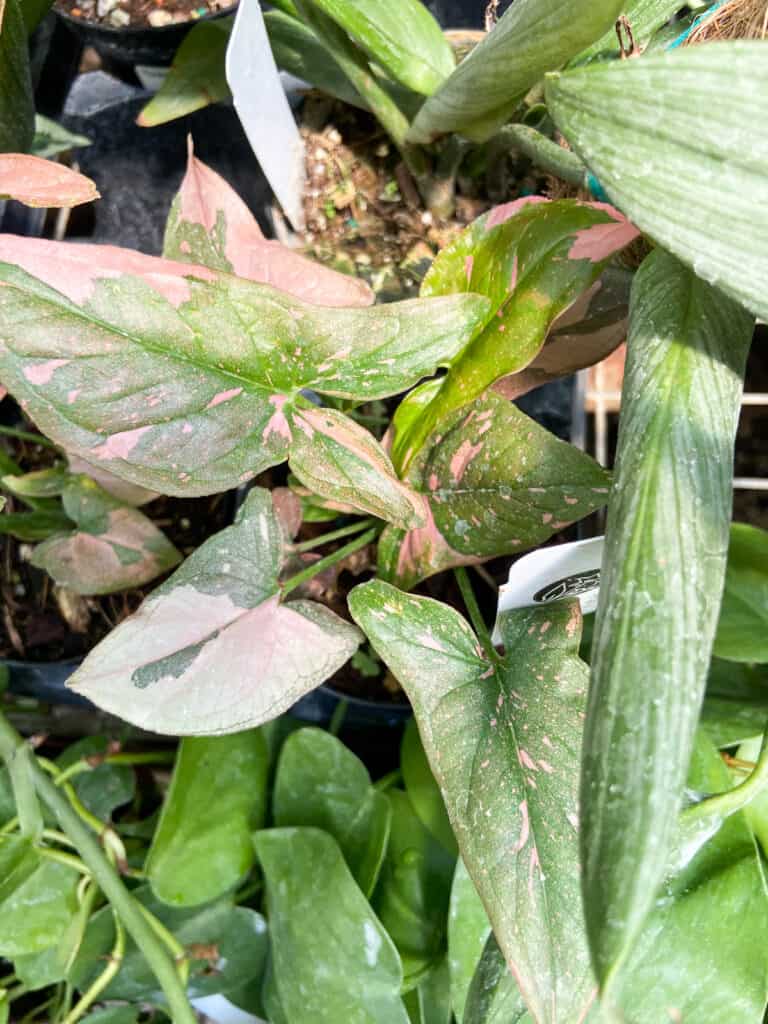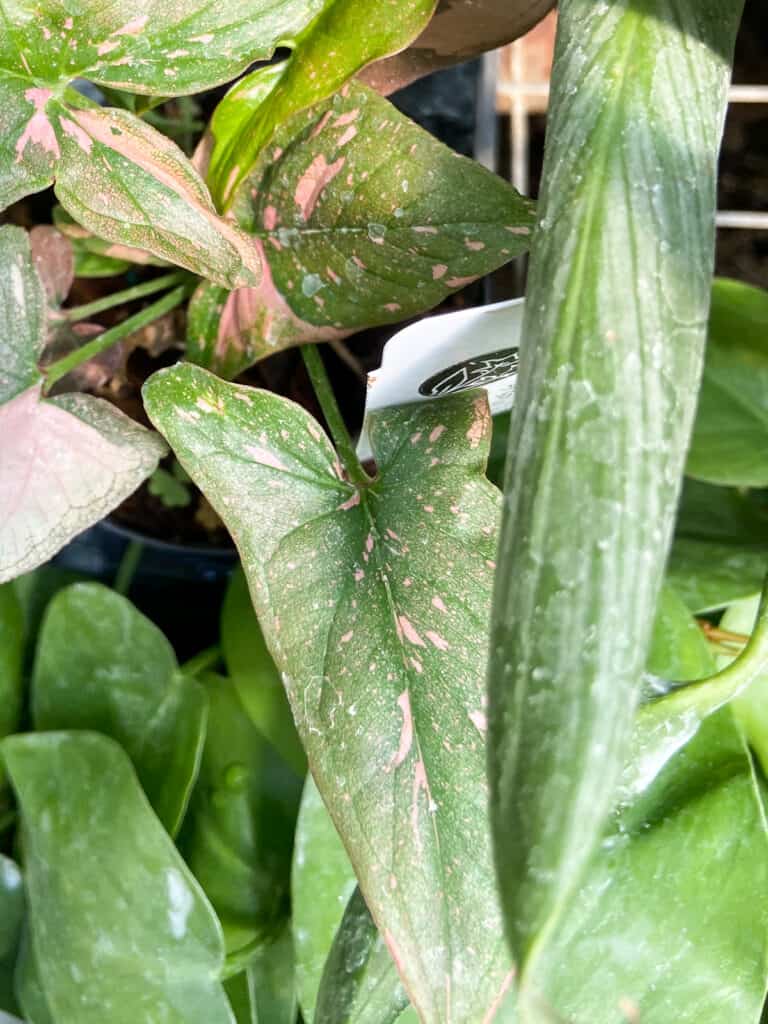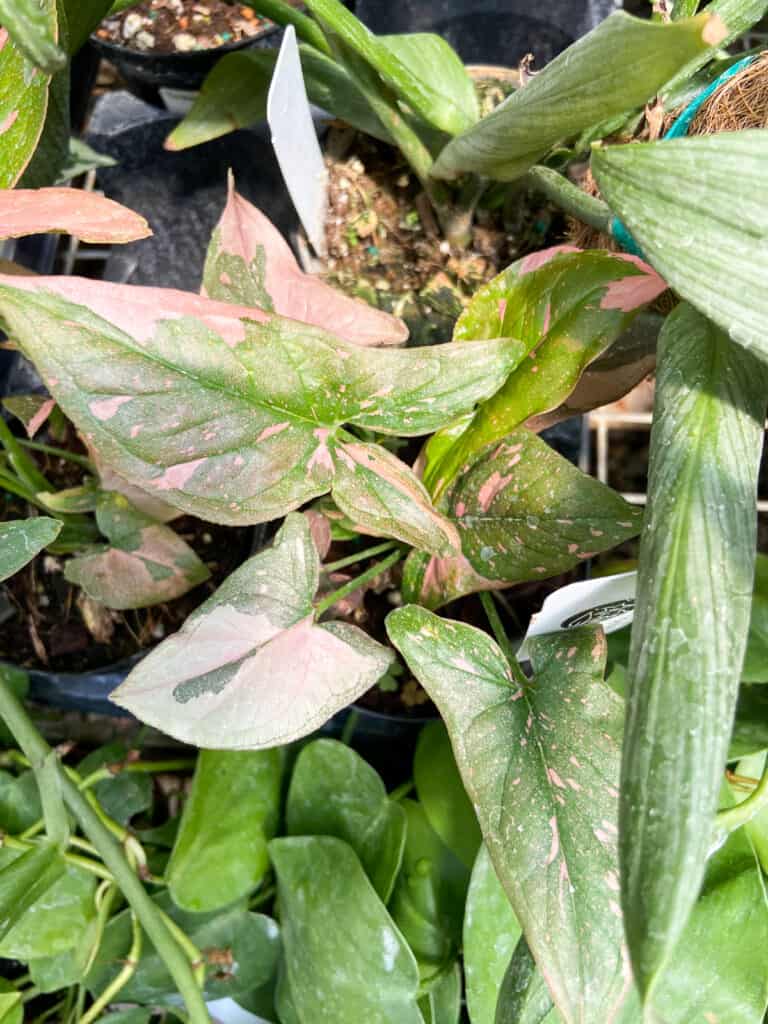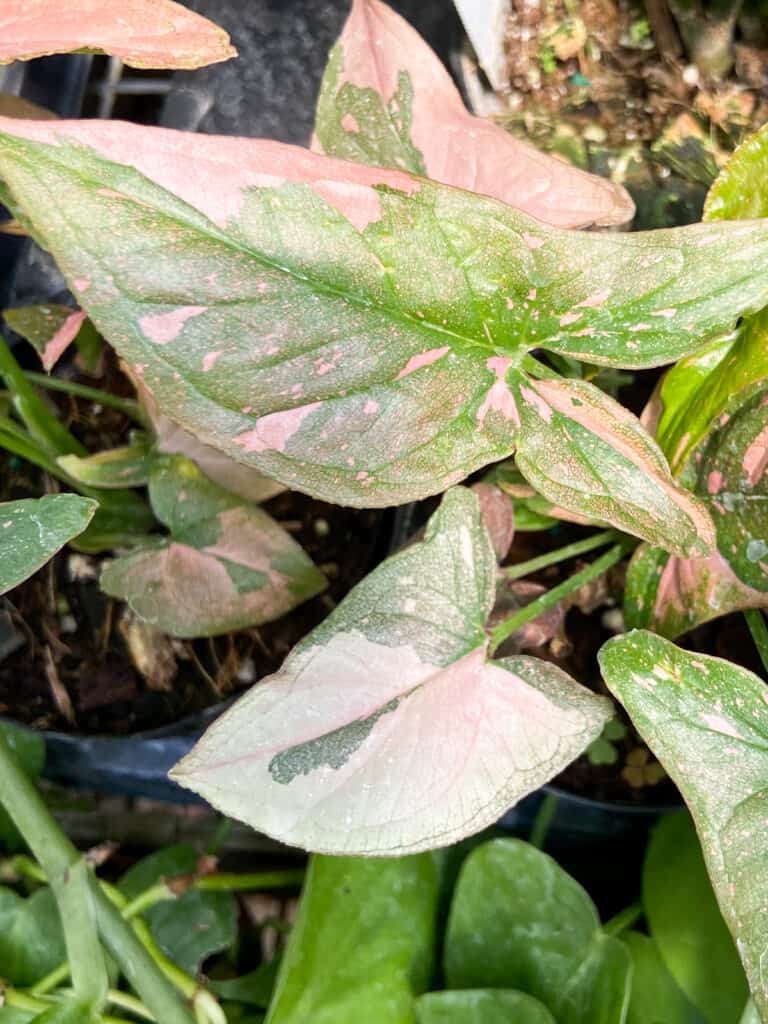The syngonium pink splash is one of the rarest and most beautiful member of the syngoniums. Despite its immeasurable beauty, you’ll be pleasantly surprised to know that the syngonium is a very easy and low-maintenance houseplant.
Follow this ultimate care guide for information on how to care for a syngonium pink splash and add a pop to your plant collection.
Table of Contents
Syngonium Background
The Syngonium podophyllum ‘Pink Splash’ is a rare and beautiful houseplant that is a member of the Syngonium genus. The word “Syngonium” refers to a genus of plants native to the tropical regions of Central and South America.
The syngonium has many common names, but the name that is best known for the syngonium is the “arrowhead vine,” which lends its name from the arrowhead shaped leaves it produces. This plant can also simply be referred to as the “pink syngonium.”
The syngonium pink splash gets its name from the very identifiable pink splotches that adorn its leaves, which is a feature that has most plant collectors sold.
If you are familiar with variegated plants, then you’ll know that these pink splashes on the leaves are dependent on the amount of light the plant receives. A lack of sunlight causes these plants to produce higher quantities of chlorophyll, resulting in less pink, but more greener leaves.
Even though syngoniums are indoor plants, they are toxic to both humans and animals when ingested. The syngonium contains a large amount of calcium oxalate crystals, which cause irritation, vomiting, and pain when it is consumed.
We highly advise plant owners to be extra cautious keeping these plants near curious pets or children.
Syngonium Pink Splash Care

Sun & Light
Syngonium plants enjoy medium to bright indirect light. Please avoid exposing your syngonium plants to direct sunlight, as this can cause the leaves to become scalded by the sun and lose that beautiful pink hue.
Your syngonium’s pink variegations are dependent on how much light it gets during the day. Too little light will result in your plant reverting back to solid green leaves.
However, as long as you maintain at least 6 hours a day of bright light, your plant will maintain its gorgeous pink splotches on its leaves.
Soil Type
Shop for a moist, yet well-draining substrate soil is best for keeping your syngonium plants happy and healthy. You can mix your own syngonium potting mix for the plants by combining equal parts potting soil, sphagnum peat moss, and perlite. Syngonium plants enjoy an acidic pH level, around 5.5 to 6.5.
Water
Similar to other tropical plants, the pink splash prefers a moderately moist environment and the watering schedule is very important. It is equally important to ensure that you do not accidentally overwater your plants.
A good rule of thumb is to allow the top few inches to dry out in between waterings with the appropriate amount of light, in order for your plant to fully thrive.
Fertilizer

Your syngonium plant will benefit greatly from a regular fertilizer routine; fertilization is essential to promoting strong, vigorous foliage growth. We recommend only fertilizing your plant during its active growing period (spring & summer). Stock up on a balanced liquid houseplant fertilizer and apply it to your plant every two weeks as part of your plant care routine.
Please cease all fertilization of your plants during the fall and winter months when the syngoniums enters its dormancy phase. Fertilization during this period can cause the soil to acidify to the point where life is unsustainable for the plants.
Temperature & Humidity
The syngonium is best known to be native to the tropical regions of Central and South America, so it is important for plant owners to try and replicate and offer warm, humid conditions that this plant is naturally accustomed to.
The ideal indoor temperature range that we recommend is between 60° and 80° F. Avoid allowing the indoor temperatures to dip below 50°.
Humidity plays just as much of an important role as temperature and light does when it comes to your pink splash plants. Please try to maintain a steady humidity level of 50% in your home for your plants.
If you are concerned that the air quality is not humid enough, we recommend placing an electric humidifier in the vicinity of your plant for best humidity results.
Pruning & Maintenance

The pink splash is a fast growing plant. With fast growing plants such as these, they can very quickly become unkempt and leggy, and large. To prevent this from happening, it is important to maintain your plant and prune when needed.
Always start by pruning any dead or damaged foliage before moving onto the healthy parts of the plant. To maintain a full pink, bushy plant, prune the bottom of the plant around 2 to 3 times per year.
Choosing a Container & Repotting Plant For Your Syngonium
As we’ve previously discussed, this plant thrives best in moist conditions. For this reason, it is essential that you shop for a plant pot has ample drainage holes.
Drainage holes in pots allow for excess moisture and water to escape from the bottom of the plant, that way your plant is moist but not waterlogged.
Syngoniums are fast growing plants, so expect to repot your plant once a year. When repotting your syngonium, you should repot very gradually and water accordingly.
Do not exceed a pot that is 2 to 3 inches larger than the previous. Repotting in a much larger pot can send your plant’s root system into shock.
How to Propagate a Syngonium Pink Splash Plants

Syngonium pink splashes can easily be propagated via stem cuttings. Since the syngonium is a rare plant, many plant owners propagate their syngonium in order to create the best genetic copy of the original plant.
Follow these straightforward instructions on how to propagate your syngonium pink splash.
- Cut off a healthy stem from your plant. The cut should be made an inch below the leaf node.
- (Optional) Some gardeners prefer to dip the cut-end of the clipping in hormone rooting powder. This is entirely optional, though it should be noted that hormone rooting powder helps increase the odds of a successful propagation.
- Prepare a small jar of water or propagation station and place the stem in the jar. Make sure only the bottom 1/3 of the stem is submerged, not the entire stem. The leaves should be above the rim of the glass to allow for airflow to circulate and reduce the risk of rot.
- Place the jar in a location with bright light and change out the water once a week. It takes roughly one month for roots to grow. Once the roots have grown to at least 1 inch in length, you may transfer the cutting into a pot and water accordingly.
- Prepare a pot with moistened potting mixture. Transplant the cutting into the soil and keep it evenly moist with water for a few weeks while the cutting takes time for the pink splash to establish itself in its new home with the appropriate amount of light.
Common Syngonium Pests
Two of the most common pests associated with syngonium plants are mealybugs and spider mites. Both of these sap-sucking bugs will latch onto the leaves of your plant and suck out the nutrients from it. We recommend checking on the leaves of your plant weekly to make sure there are no signs of lingering bugs.
These issues often appear when humidity levels are low; so maintaining a proper humidity level in your home will help keep issues at bay. While pest infestations are devastating to plant owners, there are easy and natural options at a reasonable price that you can choose to control the situation.
Both mealybugs and spider mites can best be treated by cleansing your plant with an insecticidal soap. You might have to do this twice or thrice to completely relieve your plant.
In addition, treating your plant with neem oil is a small step that is effective in both prevention and extermination of spider mites and mealybugs; not to mention that neem oil is entirely natural, making it the best alternative for plant owners who are not looking to shop for chemical insecticides.
Common Syngonium Diseases
The most common disease associated with this plant is root rot. Root rot is a terrible bacterial disease that is brought upon by improper watering techniques.
While this plant prefers a moist environment, it is also best not to overwater your plant. Too much water and not enough drainage is a recipe for disaster.
Signs of root rot include wilting, dying foliage and yellow leaves instead of those beautiful pink hues.
While root rot can be scary, it is treatable when plant owners act swiftly. Follow these simple instructions on how to alleviate root rot:
- Remove your plant from its pot. Dispose of the rotten leaves and sterilize the inside of the container.
- Inspect your plant’s root system. Rotted roots are black and mushy, as opposed to healthy roots that are firm and white.
- Using a pair of sterile scissors, cut all signs of rot.
- After the rot is cleared, repot your plant.
- Moving forward, it is important to water your plant properly to keep that pink hue vibrant. Always make sure it is moist, but not waterlogged with too much water. Wait for the top few inches of soil to dry out before watering your plant again.
FAQ
Yes, the syngonium Pink Splash is a rare plant. What makes this plant particularly rare is the pink variegation on its leaves. These pink variegations don’t always occur in syngoniums, which makes discovering a pink splash such a pleasant surprise, and a must-have for plant collectors who can admire the gorgeous leaves!
The pink variegations on the pink syngonium plant is dependent on the amount of light that your plant receives. When your plant is exposed to bright light, it displays more prominent variegations. While the pink splash syngonium is able to survive in low light conditions, this causes the variegations to revert, leading to solid green leaves.
In Conclusion
The syngonium pink splash is a beautiful houseplant with gorgeous leaves that feels like you’re bringing the tropics into your home. And the best part about owning a syngonium is how easy they are to care for!
Want more plant fun? Head to one of these plant posts!

